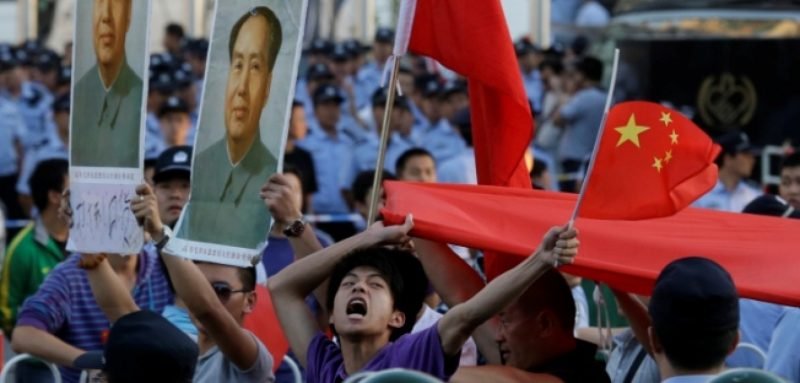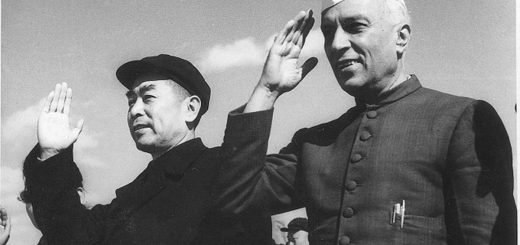Inherent contradictions of nationalism and communism in China

Chinese revolution marks one of the most important events in world history. Inspired by the Bolshevik revolution the Communist Party of China following the ideas of Marx and Lenin tried to implement communism in China. The communist party of China didn’t copy Marxism as it is but tried to ‘sinicise’ it according to the situation prevalent in the society. Chinese revolution and the role of the Communist Party of China are still highly controversial.
Chinese centrism gradually began to end with the rise of Western imperialism and the Opium war marked the end of Chinese isolationism. Opium wars were followed by the treaty of Nanking, the opening of five ports for British travelling vessels and possession of British over Hong kong. It all led to the ‘opening up’ of China. Everything started changing so fast. Chinese interaction with the Western world produced and reproduced as well as exposed the contradiction and complexity in the society. Taiping rebellion, the radical reformers (also known as hundred-day reforms) and boxers’ rebellion during that point are the examples of the emergence of contradiction in the society. Taiping rebellion and radical reformers were anti traditions and inclined towards western values and wanted the destruction of Confucianism.
On the other hand, the Boxers’ rebellion led by peasants and marginalised people were xenophobic and were largely pro dynasty. They had the support of the conservative intellectuals and officials. The crisis resulted in the formation of a Constitutional monarchy. During the rule of the Qing dynasty, certain reforms were introduced I,e adoption of western education, the abolition of traditional civil services examination etc but these reforms came too late.

But for the Communists, the May fourth movement (1919) marks the starting point for the emergence of modern China. Sometimes it’s also called ‘Chinese Enlightenment’. It questioned the very basis of the Chinese society I,e Confucianism and the Empire. Unlike the Boxers’ rebellion, the May Fourth had a very low social base. It was limited to some western educated students and professors. But its effect lasted for several years. The greatest achievement of the movement was the change in the literary language from Wen-Yen to Pai-Hua and reforms at Peking University. The Chinese literati wrote in Wen Hen whereas the masses spoke Pai-Hua. It was a revolutionary step to make literature accessible to people in the language they spoke instead of only for those who understood Wen-Hen. The significance of the May Fourth lies with its revolt against the Chinese culture. On the other hand, most of the Professors at Peking University happen to be civil servants. Ts’ai Yuan-peri the Chancellor of Peking university brought some changes into it and played a crucial role in reforming the University. He gave academic space to the scholars. Later on, till the Japanese war, the Chinese intelligentsia moved towards Marxism.
The whole modern history of China is a reaction to imperialism. It includes the series of rebellions, reforms and revolution. Imperialism put the whole existence of China into danger.
In the words of Lucian Bianco “It was through communism that nationalism triumphed”. It was not as if the empire was not nationalist but what they lacked was the strength to resist the colonial powers. The main motive of revolutionaries was to create a political establishment to strengthen their country whereas overthrowing the empire was still a secondary thing for them. And At that point, it was important to destroy the traditional feudal structure of the society that was preventing China from becoming a strong nation. The Chinese revolution is the metamorphosis of communism and Chinese nationalism which sought to fight against Imperialism at one hand and against the feudal structure and economic problem of China on the other hand.
The policy of Kuomintang to negotiate with Japanese instead of giving them the fight had a strong public response. But Chiang’s decision not to fight the war against Japan was largely realistic. Given the kind of the strength of Japan a confrontation meant China losing the war. The failure of the Kuomintang party to address the agricultural crisis and the Japanese invasion gave Mao and the Communist party an upper hand. When Japan waged the war against China, Mao systematically utilized the national sentiment in the favor of communism. The mass support that the Communists got helped them to resist the Japanese forces and later on win the civil war.
Afterwards, the huge economic crisis in China provided Communists with an immediate ground to mobilize masses particularly poor and peasantry against the Kuomintang party and its feudal social base. The base for the social conflict was that in rural China there existed two opposite classes: peasantry class and the landowning class. The composition used to be such that the minority landowning class owned more than fifty per cent of the total land in the village whereas the peasantry class which constituted the majority population lived in misery. The condition of peasants worsened over time. Poverty, hunger and death were the daily lived reality of half of the population of China. Many scholars have written about the personal experiences of the hardships and struggles of the people belonging to the peasantry class. The deteriorating condition of the masses gave a favourable condition for the communist party to lay down the foundation for the revolution. People were not prepared for the revolution; it was the communist party that Lead the movement and gave its objective.

Mao was the only one to better understand the bitterness among the peasants and to channelize that into the political and military force. In the words of Bianco, Mao was a “mediocre theoretician whose strategy seems to represent the triumph of common sense”.
Apart from this, the two major developments happened at this point that was new to the society. One was the exodus of people towards Manchuria that led to three times increase in its population and other new development was the change in the social relation between landowners and the tenants. The increase in the absentee landlordism made the upper class more inhumane.
Even though the Revolution succeeded but the mode of production of China was not advanced and the economy was still dependent on agriculture. Till the revolution society was fragmented and political instability was rampant; one after other political factions frequently changed the political system of the country. The social and economic crisis of the twentieth century was the cause of inequality deeply rooted in Chinese society. And China had to face this crisis still after the revolution of 1949. Most of the communist scholars view the nation as the imagination of the well-organized dominant community. As Marxists view Nationalism as a false consciousness that leads to the formation of the modern nation-state which is exploitative. Though China claims itself to be a Communist country, Nationalism is and has remained the driving force for the Chinese society and the Communist party. Now China has a thriving market-based economy and a capitalist class which continues to flourish. Therefore, it becomes significant to critically analyze the communism and nationalism in China.


















